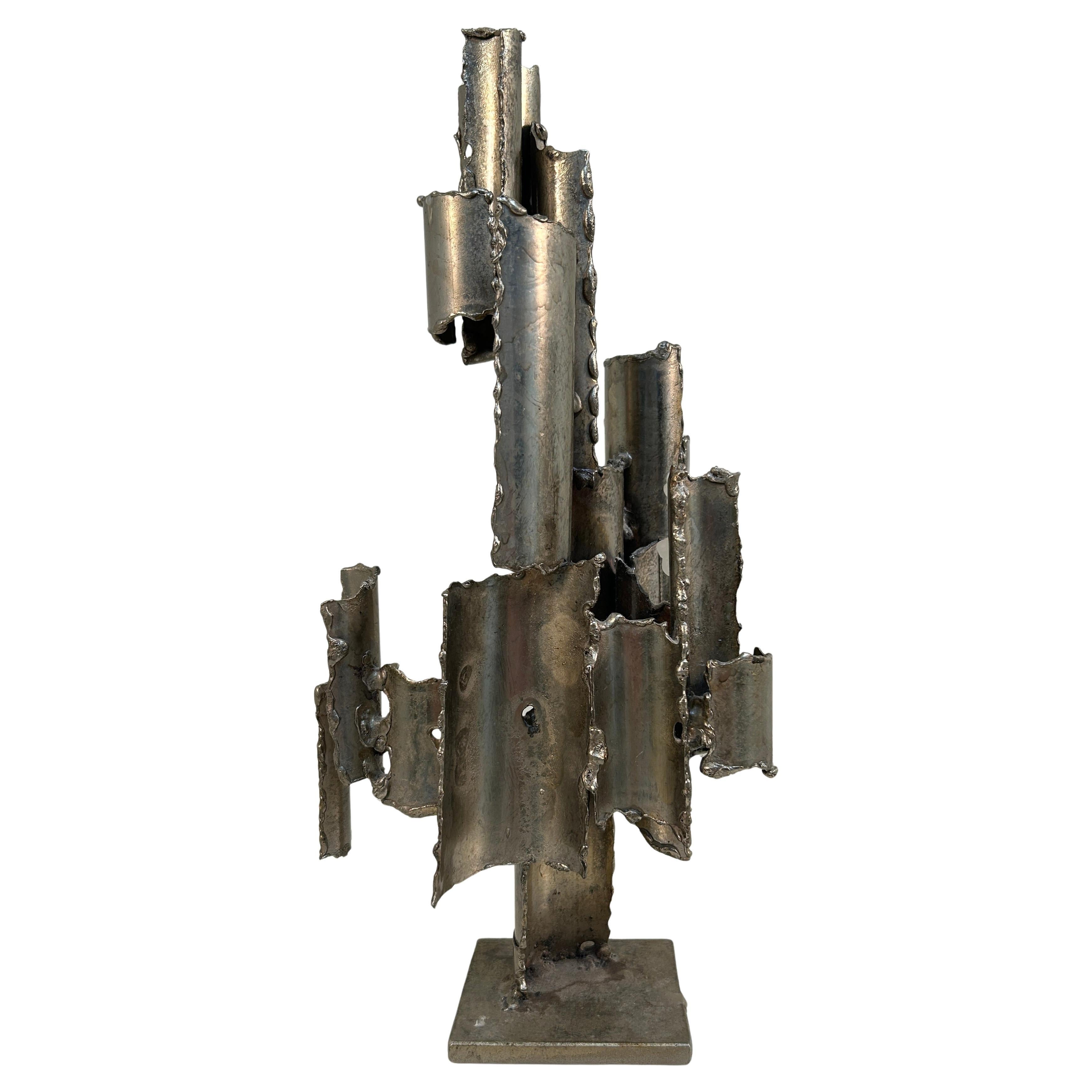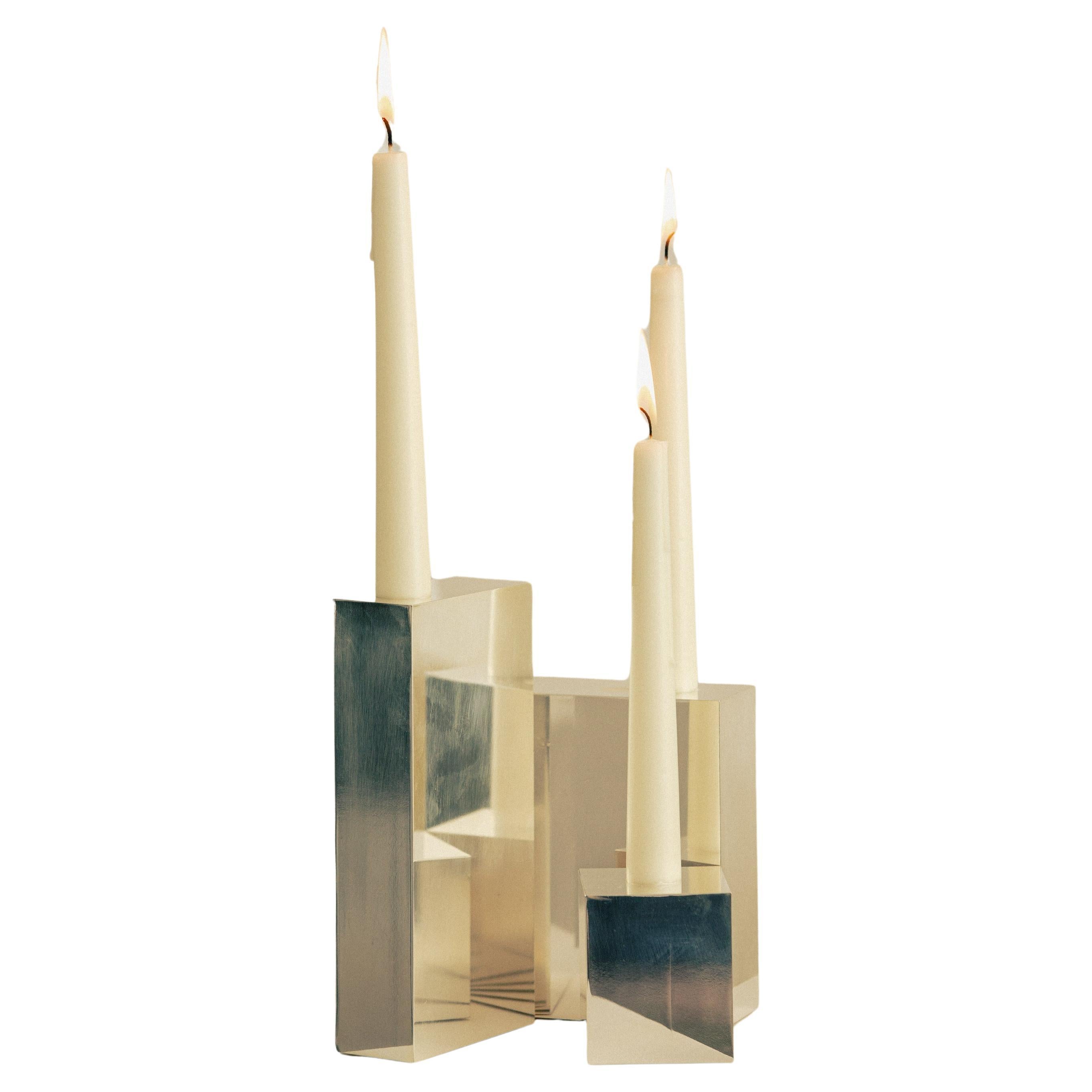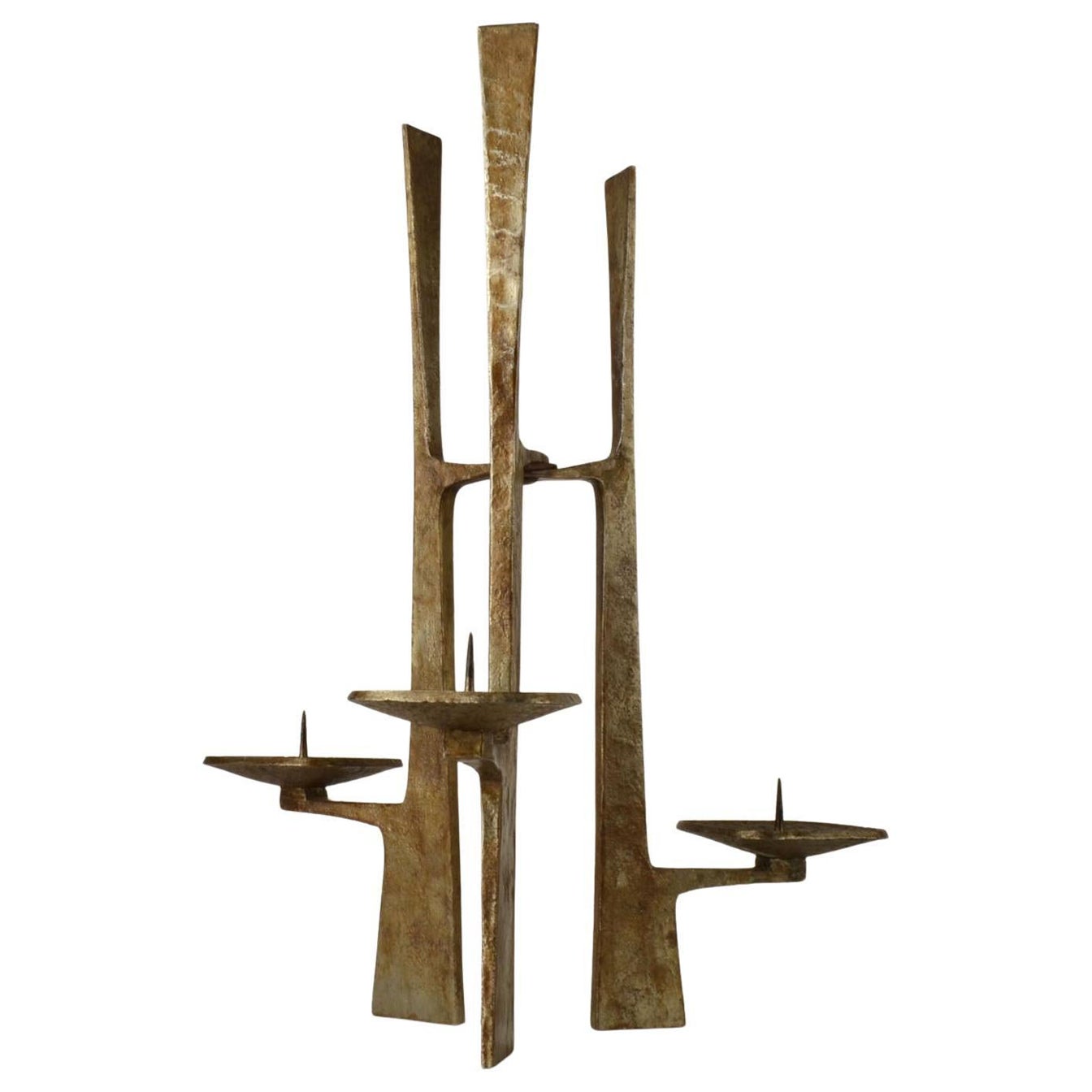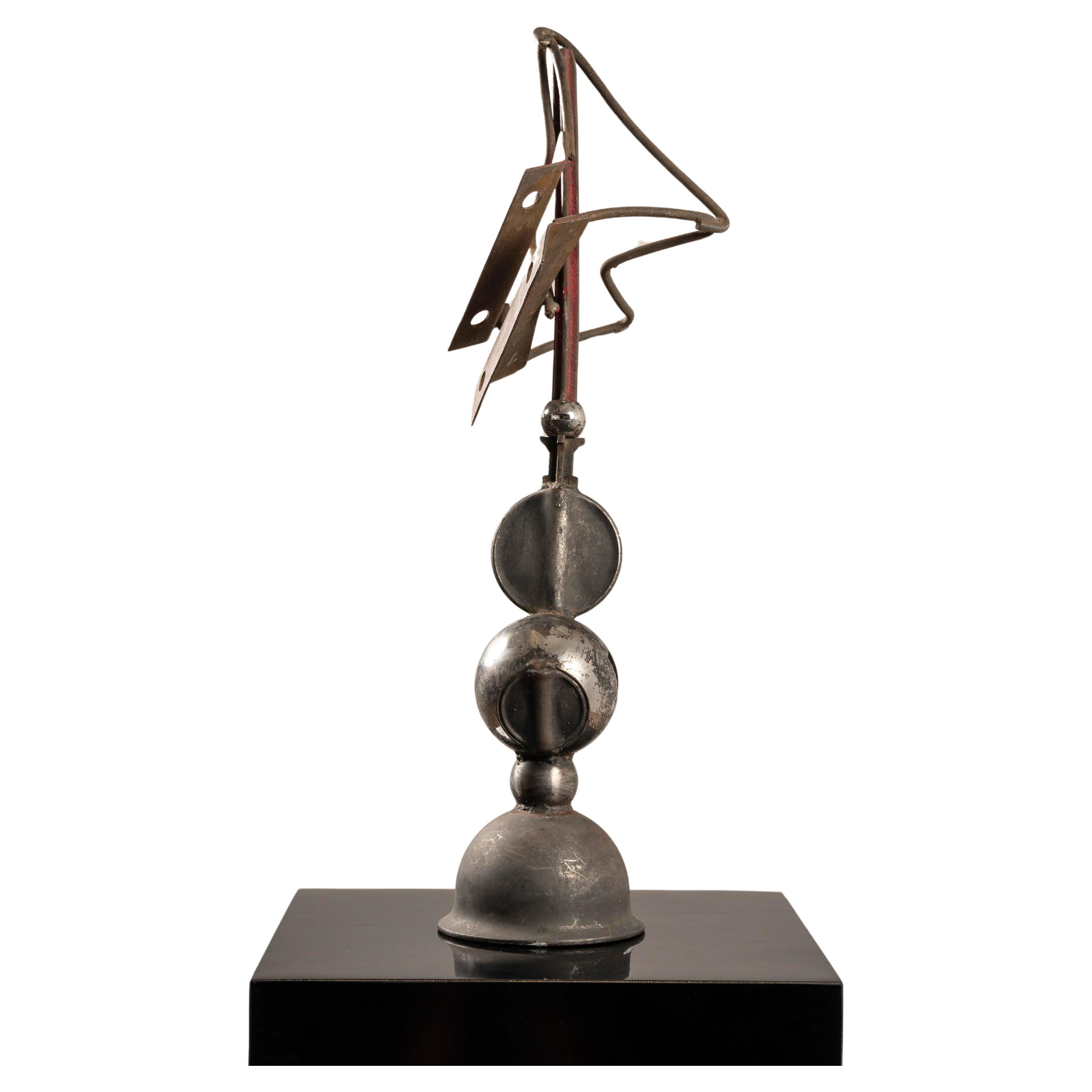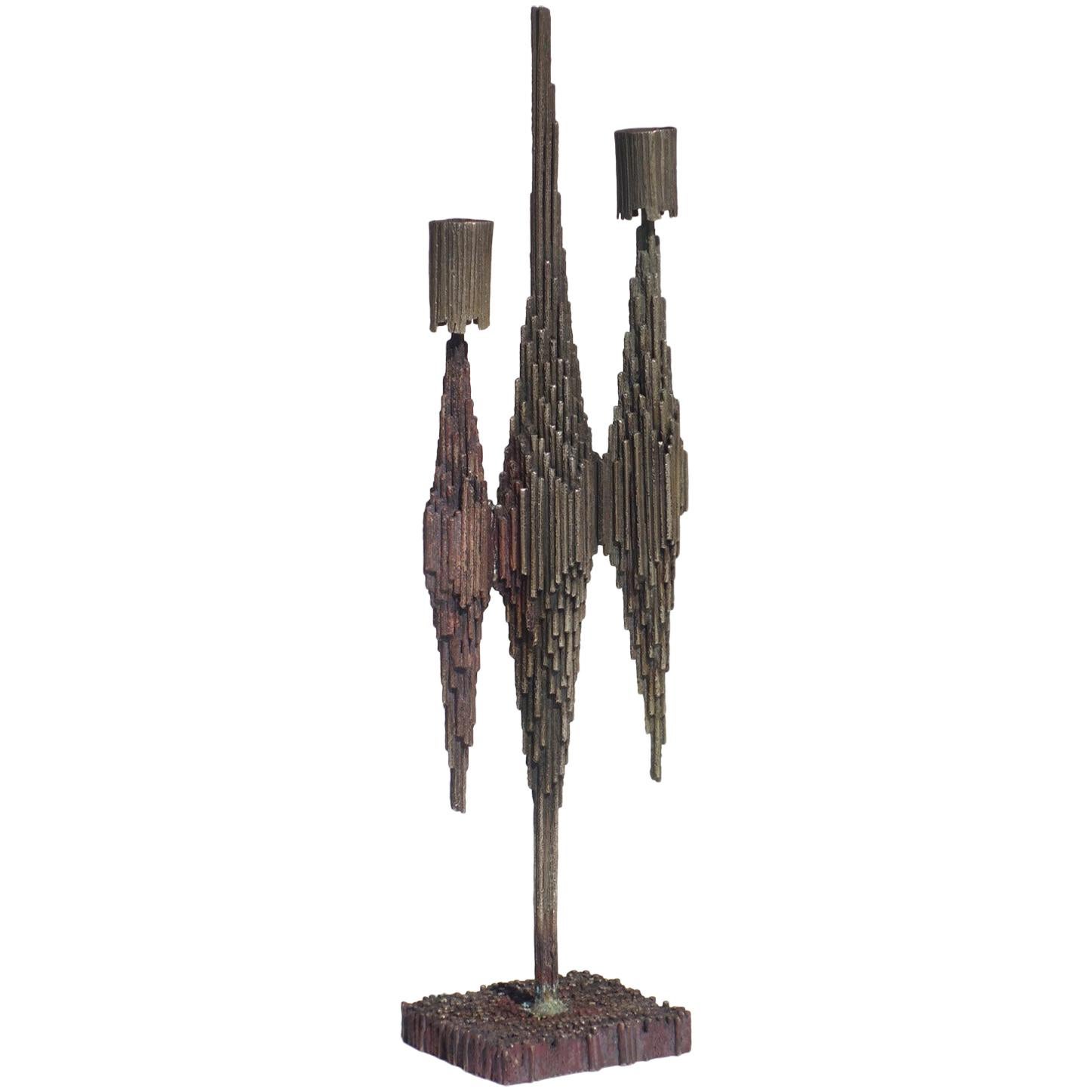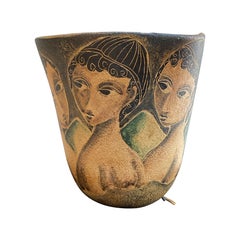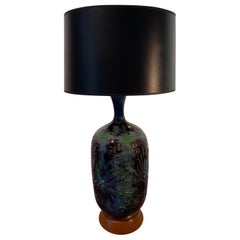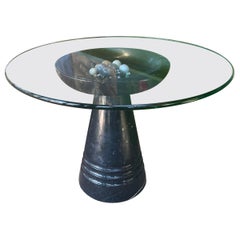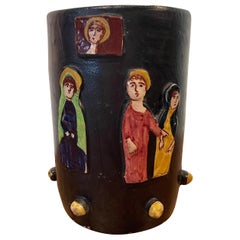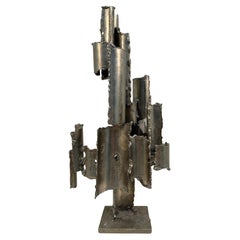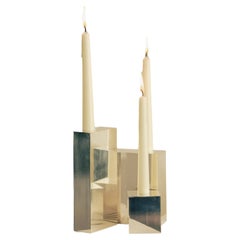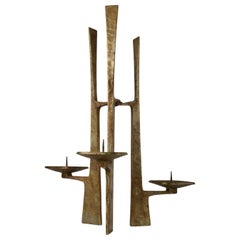Items Similar to David Zelman Sculptural Stainless Steel Candelabras Circa 1980
Want more images or videos?
Request additional images or videos from the seller
1 of 7
David Zelman Sculptural Stainless Steel Candelabras Circa 1980
$1,000per set
£760.28per set
€877.39per set
CA$1,399.73per set
A$1,567.33per set
CHF 817.75per set
MX$19,096.72per set
NOK 10,376.69per set
SEK 9,865.47per set
DKK 6,549.11per set
Shipping
Retrieving quote...The 1stDibs Promise:
Authenticity Guarantee,
Money-Back Guarantee,
24-Hour Cancellation
About the Item
A rare pair of sculptural candelabras designed by David Zelman for Prologue 2000, Inc., NYC, circa 1980s. These dynamic pieces are crafted from brushed stainless steel, reflecting Zelman’s distinctive architectural and geometric design language. The interplay of rectilinear and curved forms gives each candelabra a striking, Constructivist-inspired profile, simultaneously bold and minimal.
Produced through Zelman's design firm Prologue 2000, the candlesticks feature a stainless steel framework and chrome accents. Each candle sits on an extension that is vertically adjustable and can be turned 360 degrees. Marked, Prologue 2000, Inc., N. Y. C., on the bottom.
The C shaped candlestick measures 28" H x 13.25" W x 2.5" D
The rectangular candlestick measures 31.75": H x 10.5" W x 2.5" D
David Zelman has been creating objects that function as furniture for the past 20 years. His work can be found in the permanent collections of the Brooklyn, Kohler, Yale and Cooper Hewitt Museums. In addition, he founded and designed objects for Prologue 2000, Inc. a manufacturing and design firm. In his sculptural work he attempts to pay homage to the work of man, therefore his images of bridges, scaffolding, elevators, wheeled objects, and the like call attention to these often overlooked basics of our existence.
- Dimensions:Height: 32 in (81.28 cm)Width: 13 in (33.02 cm)Depth: 2.5 in (6.35 cm)
- Sold As:Set of 2
- Materials and Techniques:
- Period:1980-1989
- Date of Manufacture:Circa 1980
- Condition:Wear consistent with age and use.
- Seller Location:Northport, MI
- Reference Number:1stDibs: LU10351244844602
About the Seller
New to 1stDibs
Joined in the past six months.
No Reviews Yet
Vetted Professional Seller
Every seller passes strict standards for authenticity and reliability
1stDibs seller since 2025
- ShippingRetrieving quote...Shipping from: Northport, MI
- Return Policy
Authenticity Guarantee
In the unlikely event there’s an issue with an item’s authenticity, contact us within 1 year for a full refund. DetailsMoney-Back Guarantee
If your item is not as described, is damaged in transit, or does not arrive, contact us within 7 days for a full refund. Details24-Hour Cancellation
You have a 24-hour grace period in which to reconsider your purchase, with no questions asked.Vetted Professional Sellers
Our world-class sellers must adhere to strict standards for service and quality, maintaining the integrity of our listings.Price-Match Guarantee
If you find that a seller listed the same item for a lower price elsewhere, we’ll match it.Trusted Global Delivery
Our best-in-class carrier network provides specialized shipping options worldwide, including custom delivery.More From This Seller
View AllMarcello Fantoni Midcentury Italian Studio Pottery Lamp with Stylized Figures
By Marcello Fantoni
Located in Northport, MI
A signed studio pottery lamp by iconic Italian ceramicist Marcello Fantoni, crafted in the 1950s. This striking midcentury piece features a flared, tapering form with hand-painted st...
Category
Mid-20th Century Italian Table Lamps
Materials
Ceramic
Mid-Century Studio Pottery Table Lamp with Sculpted Floral Glaze and Wood Base
Located in Northport, MI
A vibrant and visually striking mid-century ceramic table lamp featuring an intricately sculpted floral design in a rich, high-gloss glaze. The bulbous ceramic body is adorned with a...
Category
Vintage 1960s Mid-Century Modern Table Lamps
Materials
Ceramic, Wood
Sculptural Marble Pedestal Table Attributed to Angelo Mangiarotti, Italy, 1980s
By Angelo Mangiarotti
Located in Northport, MI
A rare and architecturally compelling pedestal table attributed to renowned Italian designer Angelo Mangiarotti, crafted in Italy circa 1980s. This versatile piece features a substan...
Category
Vintage 1980s Italian Post-Modern Patio and Garden Furniture
Materials
Marble
Mid-Century Italian Studio Ceramic Vase with Applied Relief Figures
Located in Northport, MI
A striking mid-century Italian studio ceramic vase featuring applied relief figures and distinctive rounded accents. This cylindrical vessel is glazed in a rich black, providing a dr...
Category
Mid-20th Century Italian Brutalist Vases
Materials
Ceramic
Tiffany Studios Pine Needle Bronze Doré and Slag Seven-Piece Desk Set
By Tiffany Studios
Located in Northport, MI
An exceptional seven-piece desk set by Tiffany Studios New York, crafted circa early 20th century in the iconic Pine Needle Pattern. This finely detailed ensemble features warm bronz...
Category
Vintage 1910s American Art Nouveau Desk Sets
Materials
Bronze
Organic Lidded Stoneware Vessel with Sculptural Handles and Textural Glaze
Located in Northport, MI
A striking handcrafted lidded stoneware vessel, likely created in the 1970s–1980s, featuring a richly textured glaze in earthy tones of brown, slate, and ash. This sculptural piece i...
Category
Vintage 1970s American Organic Modern Ceramics
Materials
Ceramic
You May Also Like
Signed Torch Cut Brutalist Sculptural Metal Candelabra by Marcello Fantoni
By Marcello Fantoni
Located in South Charleston, WV
Uncommon table top Candelabra by Marcello Fantoni and signed with metal plaque. This piece allows the use of 3 candles. Part practical, mostly sculptural and with lots of patina, sty...
Category
Vintage 1950s Italian Mid-Century Modern Candelabras
Materials
Cut Steel
Contemporary Hinge Polished Silver Candelabra Candle Holders by Henry Wilson
By Henry Wilson
Located in Geneve, CH
Hinge Silver Candelabra by Henry Wilson
Dimensions: D 22 x H 19 cm
Materials: Sterling silver plated.
Available in sterling silver plated or aluminum.
Intended as the playful expre...
Category
2010s Australian Modern Candelabras
Materials
Metal, Sterling Silver
Sculptural Three-Arm Candelabra in Forged Steel
Located in London, GB
Sculptural forged steel candelabra made in the 1960's looks monumental and architectural. It has three arms is suitable for candles diameter 4-5 cm. The piece is signed by the artist.
Category
Vintage 1960s Mid-Century Modern Candelabras
Materials
Steel
Pair of art deco candlesticks in stainless steel 3 flames, Spain, 1970
Located in BARCELONA, ES
Very nice pair of art deco candlesticks in stainless steel designated and produced in Spain in the 1970s. Structure in 18/8 stainless steel that can accommodate 3 candles. Superb des...
Category
Vintage 1970s Spanish Hollywood Regency Candlesticks
Materials
Metal
Claude Viseux, Abstract Sculpture, 1970s, Stainless Steel
By Claude Viseux
Located in SAINT-SEVER, FR
Claude Viseux est un peintre, sculpteur et graveur aquafortiste et lithographe français né le 3 juillet 1927 à Champagne-sur-Oise et mort le 9 novembre 2008 à Anglet.
'est dans les années 1959-1960 que la sculpture de Claude Viseux, qualifiée de « protéiforme, onirique, fantastique » — ami de Max Ernst, Man Ray, Francis Ponge et Henri Michaux, il ne désavoue pas une parenté avec le Surréalisme9 — se substitue à la peinture, ses premières réalisations étant les objets trouvés en bord de mer qu'il pétrifie dans la cire10 d'une part, les empreintes de pierres et d'algues coulées en bronze d'autre part.
En 1960, il signe le Manifeste des 121 titré « Déclaration sur le droit à l’insoumission dans la guerre d’Algérie ».
En 1961, ses expérimentations s'orientent vers les corps organiques, notamment avec sa série Ostéales constituée d'assemblages d'os fossilisés qu'il patine ou au contraire décape, qu'il visse, scie, assemble et plastifie. Les Concrétudes ou Coulées directes qui suivent en 1961-1962 sont obtenues à partir de coulées de métal en fusion dans le sable, générant des reliefs qu'il soude sur des plaques d'acier. Il va cependant adopter rapidement l'acier inoxydable — qu'il est avec Pol Bury parmi les premiers à employer en sculpture — comme matériau de prédilection. « Il assemble divers rebus industriels — tuyaux, écrous, boulons, cuves… — pour créer des sculptures à mi-chemin du mécanique et du biologique » restitue ainsi Sophie Serra11. Claude Viseux, qui fréquente alors Jean Tinguely, Piotr Kowalski, Michel Guino, Takis et César, confirme : « Ma récupération de l'élément industriel s'élargit vers les aciers spéciaux, avec un essai de vocabulaire formel : des barres, des profilés, des sphères, des rotules, des fonds de cuves, des chambres à combustion de Boeing, des tubulures, des soupapes de navire »9.
« L'artiste entre au cœur de la réalité industrielle, prospecte dans les chaînes de montage de Renault et rôde dans les terrains vaques autour des usines », restitue donc l'encyclopédie Les Muses : « il récupère ferrailles, pièces détachées, débris de voitures, vieux châssis, toute une série d'éléments devenus inutiles. Ils les assemblent, tels quels, sans les modifier. Des créatures agressives ou pathétiques vont surgir de ce combat physique et dialectique que l'artiste livre avec la matière et entrer dans le domaine d'une poétique étrange, surnaturelle5 ». Dans les années 1967-1970, Les « structures actives » en acier inoxydable procèdent ainsi de la production industrielle de série. Elles se répartissent en familles de formes combinatoires composées par addition, soustraction, multiplication, division. Il confirme : « le monde industriel est ma nature, mon bouillon de culture, où je cherche des corps, des familles de corps, des genres, des espèces, dans un aller-retour de l'artificiel au naturel pour confondre les règnes, pour en inventer d'autres selon une géométrie organique qui féconde les différents types de structures, qui aménage la forme concernée par la forme à venir »9. En 1968, Claude Viseux s'installe à la villa Baudran à Arcueil, atelier qu'il conservera jusqu'en 1992.
Si des corps imaginaires naissent ainsi des pièces mécaniques que Claude Viseux emprunte à l'automobile, à l'avion et au bateau, en 1972, « la symétrie de ces formes pures en inox », constate Lydia Harambourg, « l'amène à s'interroger sur la notion d'équilibre instable »12. Ses Instables sont de la sorte exposés à la Biennale de Venise en 1972 où, rappelle encore Lydia Harambourg, une salle entière est consacrée « aux dessins qui reprennent son vocabulaire mécanique identitaire de sphères, toupies, hélices, anneaux, astrolabes et balanciers »12. Les Instables sont de même, en 1973, présentés à la galerie Le Point cardinal à Paris où Claude Viseux avait déjà exposé en 1968 avec Henri Michaux et Joaquin Ferrer...
Category
Vintage 1970s Unknown Sculptures and Carvings
Materials
Stainless Steel
$1,802 Sale Price
20% Off
1950s by Gallinaro Brutalist Italian Design Metal Candleholder
Located in Brescia, IT
Metal candleholder
"Gallinaro" signed
Excellent condition.
Category
Vintage 1950s Italian Brutalist More Candle Holders
Materials
Metal
More Ways To Browse
Vintage Stainless Steel Furniture
Chrome Candelabra
Adjustable Candle
Kohler Vintage Furniture
Egyptian Revival Candelabra
Pair 19th Century Meissen Porcelain Candelabra
Wrought Iron Standing Candelabra
Antique German Porcelain Candle Holder
Antler Candelabra
Henri Mercier
Silver Five Arm Candelabra
Tabletop Candelabra
French Altar Candelabra
Gunnar Ander On Sale
Mexican Silver Candelabra
Mexican Silver Candle
5 Arm Silver Candelabra
Bronze Cherub Candleholder
